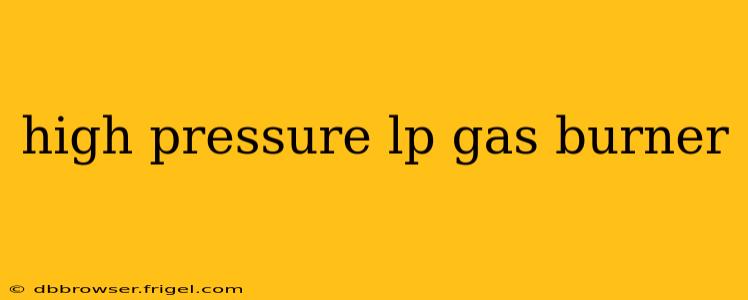High-pressure LP gas burners are essential components in various industrial and commercial applications requiring intense heat. Their efficiency and precise flame control make them ideal for diverse processes, from forging and heat treating to industrial ovens and furnaces. Understanding their functionality, safety protocols, and applications is crucial for optimal use. This guide delves into the specifics of high-pressure LP gas burners, answering common questions and offering valuable insights.
What are the advantages of high-pressure LP gas burners?
High-pressure LP gas burners offer several advantages over their low-pressure counterparts:
- Higher Heat Output: The increased pressure allows for a more efficient combustion process, resulting in a significantly higher heat output. This translates to faster heating times and increased productivity.
- Precise Flame Control: High-pressure systems offer better control over the flame's size and shape, ensuring consistent and precise heating across the target area. This is crucial for applications demanding precise temperature regulation.
- Improved Combustion Efficiency: The efficient mixing of gas and air under high pressure leads to more complete combustion, minimizing fuel waste and reducing harmful emissions.
- Compact Design: High-pressure burners often have a more compact design compared to low-pressure systems, making them suitable for space-constrained applications.
What are the different types of high-pressure LP gas burners?
Several types of high-pressure LP gas burners cater to various needs and applications. The choice depends on factors such as heat output requirements, application specifics, and budget constraints. Common types include:
- Single-stage burners: These burners deliver a consistent flame output, suitable for applications requiring steady heat.
- Multi-stage burners: Offering more precise control, multi-stage burners allow for adjustments in flame intensity, providing flexibility for different heating requirements.
- Surface combustion burners: These burners distribute the flame across a surface, providing even heating over a larger area.
- Radiant tube burners: Ideal for applications needing intense heat directed to a specific area, these burners utilize radiant heat transfer.
How does a high-pressure LP gas burner work?
The operation of a high-pressure LP gas burner involves several key steps:
- LP Gas Supply: Liquid propane (LP) gas is supplied from a pressurized tank.
- Pressure Regulation: A regulator reduces the high pressure from the tank to a suitable operating pressure for the burner.
- Gas-Air Mixing: The regulated LP gas mixes with air in a precise ratio within the burner's mixing chamber.
- Ignition: An igniter sparks to ignite the pre-mixed gas-air mixture.
- Combustion: The ignited mixture burns, producing intense heat.
- Heat Transfer: The generated heat is transferred to the target material or process.
What safety precautions should be taken when using a high-pressure LP gas burner?
Safety is paramount when operating high-pressure LP gas burners. Strict adherence to safety guidelines is essential to prevent accidents and injuries. Key precautions include:
- Proper Ventilation: Ensure adequate ventilation to prevent the accumulation of combustion byproducts.
- Leak Detection: Regularly check for gas leaks using appropriate leak detection equipment.
- Flame Monitoring: Implement flame monitoring systems to ensure continuous operation and automatic shutdown in case of flame failure.
- Personal Protective Equipment (PPE): Always wear appropriate PPE, including safety glasses, gloves, and heat-resistant clothing.
- Regular Maintenance: Schedule routine maintenance checks to identify and address any potential issues.
What are the common applications of high-pressure LP gas burners?
High-pressure LP gas burners find use in various industrial and commercial settings, including:
- Heat Treating: Precise temperature control is critical for heat treating processes like annealing and hardening.
- Forging: High-pressure burners are used in forging operations to quickly heat metal to the desired temperature for shaping.
- Industrial Ovens and Furnaces: These burners provide the intense heat needed for baking, drying, and other industrial processes.
- Ceramic Kilns: Precise temperature control is essential for firing ceramic products.
How do I choose the right high-pressure LP gas burner for my needs?
Selecting the appropriate high-pressure LP gas burner depends on several factors:
- Heat Output Requirements: Determine the required heat output based on the application's needs.
- Application Specifics: Consider the specific application's requirements, such as the type of material being heated and the desired temperature range.
- Space Constraints: Evaluate the available space to ensure the burner fits properly.
- Budget: Factor in the cost of the burner, installation, and maintenance.
This guide provides a comprehensive overview of high-pressure LP gas burners. Remember to always consult professional guidance and adhere to safety regulations when working with these systems. The information provided here is for general knowledge and should not be considered professional advice.
